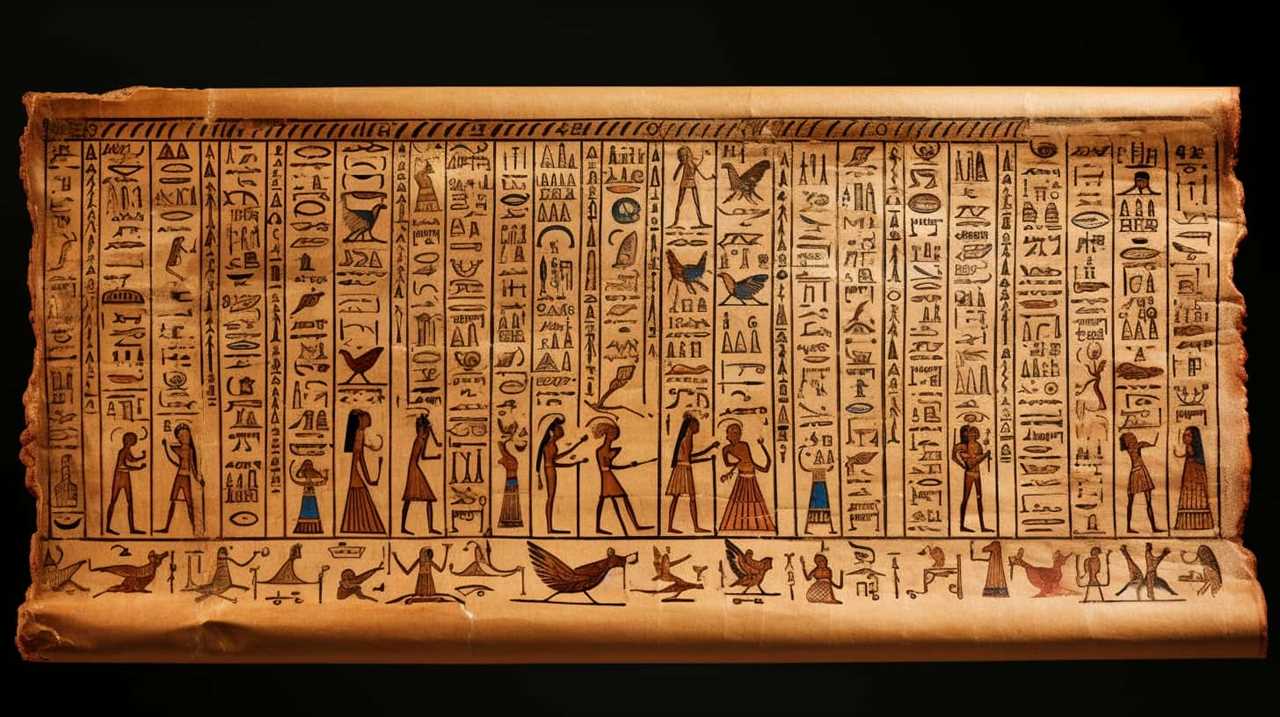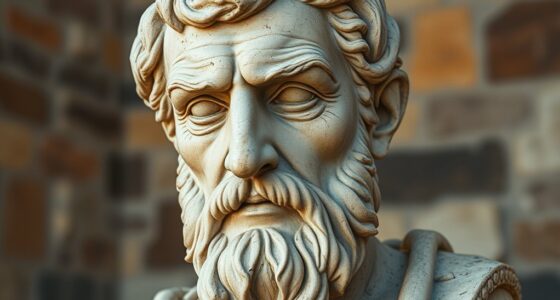Hello, seekers of wisdom!
Today, we embark on a journey through the ancient Greek world, exploring the timeless words of the wise. In this compilation of the 10 best ancient Greek quotes for life guidance, we delve into the profound teachings of Socrates, Aristotle, Plato, and more.
These luminaries of the past offer us invaluable insights into the art of living a fulfilling and meaningful life. With their words, we discover the power of self-reflection, the pursuit of excellence, the importance of knowledge, and the nature of change.
We also learn about the virtues of simplicity, contentment, and resilience. So, let us delve into these ancient treasures, for within them lie the keys to mastery in the art of living.

Key Takeaways
- The examined life is essential for true wisdom and fulfillment, according to Socrates.
- Aristotle emphasizes the cultivation of virtuous habits and moral education as crucial for achieving excellence and a fulfilling life.
- The pursuit of excellence requires deliberate effort, consistent practice, and the development of virtues.
- Plato highlights the power of knowledge in making informed choices, personal growth, and accessing eternal truths through philosophy.
Socrates on the Unexamined Life
In our exploration of ancient Greek wisdom, we come face to face with Socrates’ profound insight on the importance of not living an unexamined life. Socrates’ influence on Western philosophy can’t be overstated, and his teachings continue to resonate with us today.
At the heart of his philosophy lies the idea that true wisdom and fulfillment can only be achieved through self-reflection and the examination of one’s own life.
Socrates believed that many people go through life without ever questioning their beliefs, values, or actions. They simply follow societal norms and conventions without critically evaluating them. According to Socrates, this kind of unexamined life isn’t worth living. He argued that by engaging in deep introspection and questioning, individuals can uncover their own biases, contradictions, and inconsistencies. This process of self-examination leads to self-awareness, personal growth, and the pursuit of truth.
By encouraging us to examine our lives, Socrates challenges us to confront our own ignorance and strive for self-improvement. He believed that true knowledge begins with acknowledging our own limitations and being open to questioning and learning.

Socrates’ influence on the importance of examining one’s life serves as a powerful reminder to constantly seek self-awareness and to question the assumptions and beliefs that shape our existence. Only through this ongoing process of examination can we hope to lead lives that are truly meaningful and fulfilling.
Aristotle on Virtue and Excellence
When examining Aristotle’s views on virtue and the pursuit of excellence, we’re presented with a profound understanding of human nature and moral character. Aristotle believed that virtue isn’t merely a state but a habit, something that’s cultivated and practiced over time.
He argued that excellence, or eudaimonia, is achieved through the development of virtuous habits and the fulfillment of one’s potential as a rational being. Ultimately, Aristotle’s teachings on virtue and excellence provide valuable guidance on how to live a fulfilling and morally upright life.
Aristotle’s Views on Virtue
Our exploration of Aristotle’s views on virtue reveals its significance in guiding our lives towards excellence and moral excellence.

Aristotle believed that virtue isn’t simply a state of being, but rather a habit that’s cultivated through moral education and practice. He argued that the ultimate goal of human life is to achieve eudaimonia, which can be translated as ‘flourishing’ or ‘living well.’
According to Aristotle, eudaimonia can only be achieved through the cultivation of virtuous habits and the pursuit of moral excellence. He believed that moral education plays a crucial role in this process, as it helps individuals develop the virtues necessary for a fulfilling and meaningful life.
Aristotle’s views on virtue provide us with a framework for understanding the importance of moral education and the cultivation of virtuous habits in our own lives.
Pursuit of Excellence
We strive for excellence by cultivating virtuous habits and embodying moral excellence, as Aristotle’s teachings on virtue and excellence guide our pursuit.

Aristotle believed that excellence isn’t simply a result of chance or luck, but rather a product of deliberate effort and practice. He argued that achieving greatness requires the cultivation of virtues, such as courage, temperance, and justice. These virtues, according to Aristotle, aren’t innate qualities, but rather habits that must be cultivated through consistent practice and self-discipline.
Plato on the Power of Knowledge
Plato, one of the most influential philosophers of ancient Greece, believed that knowledge is the ultimate power. His wisdom on knowledge continues to resonate in our modern world.
In order to truly empower ourselves, Plato suggests that we must actively seek knowledge and engage in a lifelong pursuit of learning.
Knowledge as Ultimate Power
One of the most profound insights from ancient Greek philosophy is that knowledge holds the ultimate power in shaping our lives and the world around us.

The power of knowledge in decision making is undeniable. With knowledge, we’re equipped with the tools and understanding to make informed choices, avoiding the pitfalls of ignorance and blind faith.
Additionally, knowledge plays a vital role in personal growth and development. It allows us to expand our horizons, challenge our beliefs, and continuously learn and evolve as individuals.
Plato’s Wisdom on Knowledge
Continuing our exploration of the power of knowledge, it’s crucial to delve into Plato’s wisdom on the subject.
Plato, the ancient Greek philosopher, believed that true knowledge lies in the realm of ideas, which he called the ‘Forms.’ According to Plato’s theory of Forms, the physical world we perceive is merely a reflection of the perfect and unchanging Forms.

To attain knowledge, one must engage in philosophy, the pursuit of wisdom and understanding. Philosophy, for Plato, isn’t just an intellectual exercise but a way of life that enables individuals to detach themselves from the illusions of the material world and access the eternal truths.
Through philosophy, we can transcend the limitations of our senses and reach a higher level of knowledge and enlightenment. By embracing Plato’s teachings, we can harness the power of knowledge to transform our lives and seek true empowerment through understanding.
Now, let’s delve into the importance of seeking knowledge for empowerment.
Seeking Knowledge for Empowerment
Delving into the power of knowledge, seeking understanding becomes a means of empowerment for us all. In the philosophy of self-improvement, ancient wisdom offers valuable insights for modern life. Here are three key aspects to consider:

- Knowledge as a catalyst: Plato believed that knowledge has the power to ignite change within individuals. By seeking knowledge, we can challenge our existing beliefs and expand our understanding of the world. This process of self-reflection and growth empowers us to make informed decisions and pursue personal development.
- Liberation from ignorance: Plato saw ignorance as a hindrance to true empowerment. He emphasized the importance of seeking knowledge to free ourselves from the chains of ignorance. By acquiring knowledge, we can overcome limitations, broaden our perspectives, and gain a deeper understanding of ourselves and the world around us.
- The transformative power of self-discovery: Plato believed that true empowerment comes from self-discovery and understanding our own nature. By delving into the depths of our being, we can uncover our strengths, weaknesses, and potential. This self-awareness allows us to tap into our true power and make meaningful contributions to our own lives and society.
Epicurus on the Pursuit of Happiness
In our search for guidance on the pursuit of happiness, let’s turn to Epicurus, the ancient Greek philosopher known for his insightful perspectives.
Epicurus believed that the ultimate goal in life is to achieve happiness, and he developed a philosophy centered around the pursuit of pleasure.
For Epicurus, pleasure wasn’t merely the indulgence in physical sensations or fleeting desires. Instead, he advocated for a deeper understanding of pleasure as the absence of pain and the fulfillment of our natural needs. He emphasized the importance of cultivating inner peace and tranquility, as well as the pursuit of simple pleasures that bring long-term fulfillment.
According to Epicurus, true happiness is found in the moderation of desires, the avoidance of unnecessary wants, and the appreciation of the present moment. He encouraged individuals to seek pleasure in intellectual pursuits, meaningful relationships, and the enjoyment of nature. By focusing on these aspects of life, one can attain a state of contentment and genuine happiness.

In conclusion, Epicurus offers profound insights into the pursuit of happiness through his philosophy of pleasure. By embracing moderation, simplicity, and the cultivation of inner peace, individuals can find lasting happiness and fulfillment.
With this understanding, let’s now explore Heraclitus’ thoughts on the nature of change in our journey towards wisdom and enlightenment.
Heraclitus on the Nature of Change
When considering the nature of change, Heraclitus argues that it’s an inherent characteristic of existence. He posits that everything is in a constant state of flux, and that stability is merely an illusion.
Rather than fearing or resisting change, Heraclitus emphasizes the importance of embracing it and recognizing its role in shaping our lives. This perspective challenges our tendency to seek permanence and control, urging us to accept the unpredictable and adapt to the ever-changing nature of the world.

Change as Constant Flux
We believe that Heraclitus offers profound insights on the nature of change and its constant flux. His philosophy encourages us to embrace change rather than resist it, recognizing that change is an essential aspect of life. Here are three key points to consider:
- Change is inevitable: According to Heraclitus, everything is in a state of constant flux. Nothing remains the same; everything is constantly changing and transforming. We must accept this reality and learn to adapt.
- Finding stability within change: While change may seem chaotic, Heraclitus suggests that there’s an underlying order and harmony to the universe. By understanding and aligning ourselves with this cosmic rhythm, we can find stability and navigate through the ever-changing world.
- The unity of opposites: Heraclitus believed that opposites are interconnected and dependent on each other. Change is the result of the tension between opposing forces. By embracing this duality, we can better understand the nature of change and find balance in our lives.
Heraclitus’ teachings remind us that change isn’t something to be feared, but rather a natural and necessary part of our existence.
Embracing the Unpredictable
Let’s explore Heraclitus’ perspective on the unpredictable nature of change and its importance in our lives.
According to Heraclitus, change is an inherent and fundamental aspect of existence. He believed that everything is in a state of constant flux, and that nothing remains the same.

In embracing uncertainty, we acknowledge the transient nature of life and find peace in the chaos. Rather than resisting change, Heraclitus encourages us to embrace it and see it as an opportunity for growth and transformation.
By accepting the unpredictable nature of life, we can cultivate a sense of resilience and adaptability. Instead of fearing the unknown, we can learn to navigate through it with grace, finding peace amidst the ever-changing circumstances.
Heraclitus’ wisdom reminds us that change isn’t something to be feared, but rather embraced as an integral part of our journey towards self-discovery and enlightenment.
Pythagoras on the Harmony of the Universe
Pythagoras expounded on the concept of the cosmic order, emphasizing the harmony that permeates the universe. For Pythagoras, the universe was a complex symphony, where everything was interconnected and resonated with mathematical precision. His mathematical discoveries, particularly the Pythagorean theorem, provided a framework for understanding the underlying harmony of the universe.

Here are three key aspects of Pythagoras’ teachings on the harmony of the universe:
- Mathematical Beauty: Pythagoras believed that mathematics was the language of the cosmos. By studying the proportions and relationships between numbers, one could uncover the inherent beauty and harmony of the universe. The Pythagorean theorem, which relates the lengths of the sides of a right-angled triangle, exemplifies this harmony and is still widely used today in various applications.
- Musical Harmony: Pythagoras saw a direct connection between mathematics and music. He believed that musical intervals could be expressed as ratios of whole numbers, reflecting the harmony of the celestial spheres. This idea laid the foundation for the development of musical theory and the understanding of musical harmony.
- Cosmic Order: According to Pythagoras, the universe operated according to fixed laws and principles. He believed that everything in nature followed a predetermined order, and this order could be understood through the study of mathematics and philosophy. By aligning oneself with this cosmic order, one could achieve spiritual enlightenment and live in harmony with the universe.
With Pythagoras’ emphasis on the harmony of the universe, we transition into the subsequent section about Diogenes’ teachings on simplicity and contentment.
Diogenes on Simplicity and Contentment
Continuing the exploration of ancient Greek wisdom, we delve into Diogenes’ profound teachings on the virtues of simplicity and contentment.
Diogenes, the famous Cynic philosopher, advocated for a life of minimalism and self-sufficiency. He believed that by simplifying our lives and reducing our desires, we can find true contentment and freedom.

Diogenes rejected the societal norms and materialistic pursuits that often distract us from what truly matters. He famously lived in a barrel, possessing only the bare essentials. His rejection of material wealth and status symbolized his commitment to a life of simplicity. Diogenes believed that by freeing ourselves from the burdens of excessive possessions, we can focus on cultivating inner peace and tranquility.
Finding contentment, according to Diogenes, isn’t dependent on external circumstances or the accumulation of wealth. It’s an inner state of being that can be achieved through self-discipline and detachment from worldly desires. By embracing a minimalist lifestyle and practicing self-restraint, we can discover the true sources of joy and fulfillment.
In today’s fast-paced world, Diogenes’ teachings on simplifying life and finding contentment are more relevant than ever. In a society driven by consumerism and the constant pursuit of more, we often overlook the simple pleasures and fail to find true happiness. Diogenes reminds us that by letting go of our attachments and embracing a life of simplicity, we can experience a greater sense of peace, contentment, and fulfillment.
Sophocles on the Importance of Self-Knowledge
One of the most profound insights on understanding oneself comes from Sophocles, who emphasizes the crucial role of self-knowledge in our lives. Through his plays, Sophocles explores the themes of self-reflection and introspection, offering valuable lessons on the importance of knowing ourselves.

- Self-reflection: Sophocles believed that true wisdom can only be attained through self-reflection. By looking inward and examining our thoughts, emotions, and actions, we gain a deeper understanding of ourselves and our place in the world. This self-awareness allows us to make better choices and live more fulfilling lives.
- Introspection: In his works, Sophocles often presents characters who are confronted with their own flaws and mistakes. Through introspection, these characters are able to acknowledge their shortcomings and learn from their experiences. Sophocles teaches us that introspection is essential for personal growth and development.
- The pursuit of self-knowledge: Sophocles encourages us to actively seek self-knowledge. By questioning our beliefs, values, and motivations, we can uncover hidden truths about ourselves. This journey of self-discovery isn’t always easy, but it’s necessary for personal transformation and living an authentic life.
Thales on the Essence of Water
In the realm of ancient Greek wisdom, Thales offers profound insights on the essence of water. Thales, the pre-Socratic philosopher from Miletus, believed that water is the fundamental element from which everything else arises. He claimed that all things in the world, including the cosmos, are composed of water in varying forms. This philosophy may seem simplistic at first glance, but its significance lies in its underlying principles.
Thales’ philosophy of water has had a lasting impact on modern science and philosophy. His belief in the essential nature of water laid the foundation for the study of matter and its properties. It influenced the development of scientific theories and experimental methods, particularly in the field of chemistry. Thales’ emphasis on water’s transformative power also resonates with the concept of change and growth in philosophy, psychology, and personal development.
Furthermore, Thales’ teachings on the essence of water have shaped our understanding of the natural world. His ideas paved the way for future scientists to explore and explain natural phenomena, such as the water cycle, the properties of liquids, and the structure of molecules. Thales’ philosophy continues to inspire and guide scientific inquiry, encouraging us to delve deeper into the mysteries of the universe.
Zeno on Stoic Resilience and Acceptance
With regard to stoic resilience and acceptance, we can learn valuable life lessons from Zeno’s teachings. Zeno of Citium, the founder of Stoicism, believed in the power of resilience and acceptance as essential virtues for leading a fulfilling life. Here are three key insights we can gain from Zeno’s philosophy:

- Endurance in the face of adversity: Zeno taught that developing resilience is crucial to navigating life’s challenges. He believed in accepting and embracing the inevitable hardships that come our way, rather than resisting or trying to control them. By cultivating inner strength and resilience, we can endure hardships with grace and emerge stronger.
- Embracing the present moment: Zeno emphasized the importance of living in the present and accepting things as they are. He believed that by accepting the present moment, we can find inner peace and contentment. Stoic resilience lies in acknowledging and embracing the reality of the present, rather than dwelling on the past or worrying about the future.
- Finding harmony with nature: Zeno believed in aligning oneself with the natural order of the universe. Stoic resilience involves accepting the things we can’t change and focusing on what’s within our control. By understanding and accepting the interconnectedness of all things, we can find peace and live in harmony with nature.
Frequently Asked Questions
What Are Some Practical Tips on How to Apply Socrates’ Philosophy of Examining One’s Life?
To apply Socrates’ philosophy of self-reflection and life examination, we must engage in deep introspection, question our beliefs, and seek wisdom. By cultivating a critical mindset and constantly examining our lives, we can strive for self-improvement and personal growth.
How Did Aristotle Define Virtue and Excellence, and How Can We Cultivate These Qualities in Our Own Lives?
To cultivate virtue and excellence, we must understand Aristotle’s concept and apply practical tips for self-examination. Incorporating Socrates’ philosophy, Plato’s emphasis on knowledge, and Epicurus’ pursuit of happiness, we can grasp Heraclitus’ understanding of change in our own lives.
Can You Provide Examples of How Plato Emphasized the Power of Knowledge in His Teachings?
Plato’s emphasis on knowledge is evident in his philosophy of the Forms. He believed that true knowledge comes from understanding the eternal and unchanging Forms, which are the ultimate reality behind the physical world.
What Are Some Practical Ways in Which We Can Pursue Happiness, According to Epicurus’ Philosophy?
To discover practical ways to pursue happiness according to Epicurus’ philosophy, we must understand the importance of living simply and seeking pleasure in moderation. By adopting these principles, we can find true contentment and fulfillment in life.

How Did Heraclitus Explain the Nature of Change, and What Implications Does It Have for Our Understanding of the World?
Heraclitus’ philosophy on the nature of reality and its implications for our understanding of change have profound consequences. His concept of change challenges our perception of reality, forcing us to question the stability of the world.
Can Ancient Greek Quotes Provide the Same Life Guidance as Life Lessons From Philosophers?
Ancient Greek quotes from timeless life lessons Greek philosophers can certainly provide valuable life guidance. The wisdom and insights from philosophers like Socrates, Plato, and Aristotle are still relevant today. Their principles on ethics, morality, and the meaning of life continue to offer profound insights for modern individuals seeking guidance.
Conclusion
In the vast realm of ancient Greek wisdom, these ten quotes stand as beacons of timeless guidance for our lives. Like a compass in a storm, they offer us direction and purpose, urging us to examine our existence, pursue virtue, and seek knowledge.
They remind us of the importance of simplicity, self-knowledge, and resilience in the face of change. Let these words of ancient wisdom resonate within us, guiding our journey towards a fulfilled and meaningful life.
Lauren’s talent in writing is matched by her passion for storytelling. Her love for books and deep understanding of culture and entertainment add a distinct flavor to her work. As our media and press contact, Lauren skillfully bridges the gap between afterQuotes and the broader media landscape, bringing our message to a wider audience.










